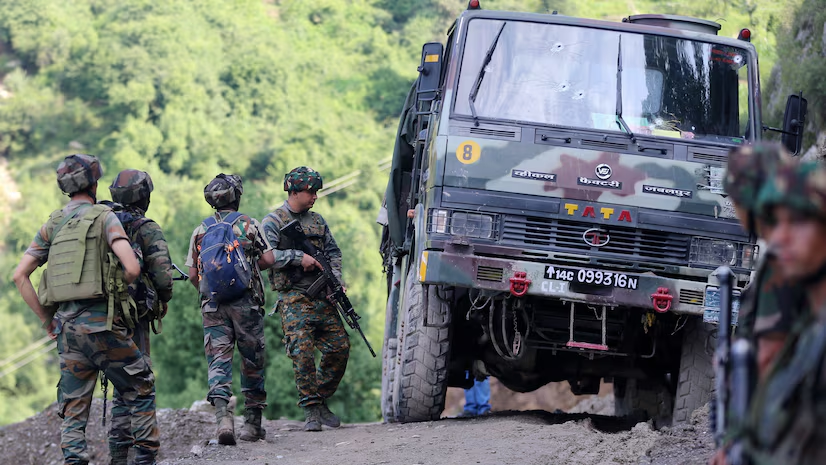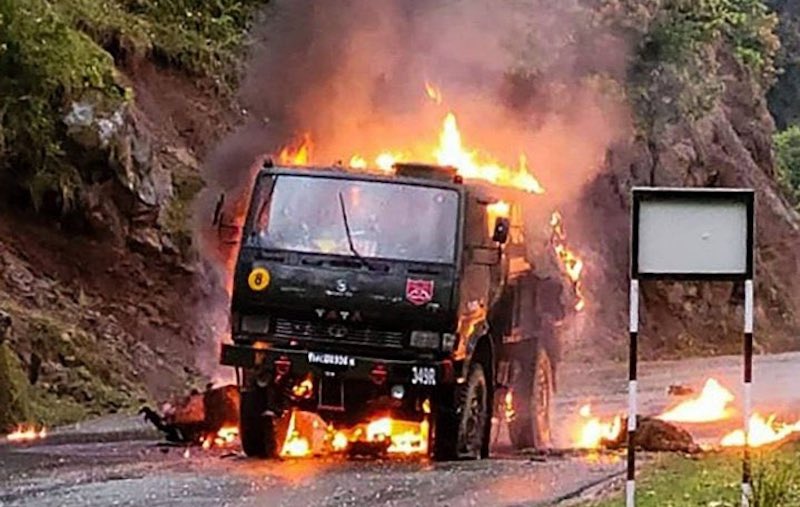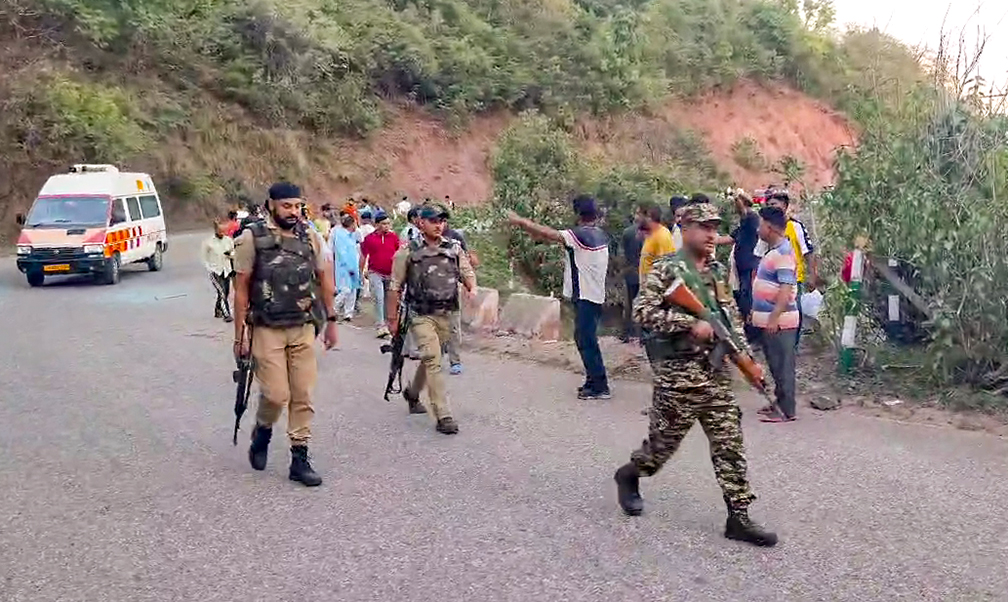Why Is There A Sudden Increase in Terror Attacks In Jammu? Are These Retired Pakistani Army Personnel Or Highly Trained Terrorists? Jammu, The New Epicenter Of Terrorism With Divergent Tactics Unseen In the Last Two Decades

This morning, in a rapidly escalating series of attacks, security forces launched a massive search operation in J&K’s Rajouri district.
This was after terrorists fired at the Indian Army’s new camp in the Gundha Khawas area early Monday morning. Alert security forces thwarted the terrorists’ attempt, and a fierce gun battle is currently underway.
This attack closely follows a similar incident where two Army personnel were injured in a gunfight with terrorists in Doda district on Thursday.
In Jaddan Bata village, around 2am, terrorists targeted a temporary camp at a government school. One critically injured soldier had to be evacuated to the Udhampur command hospital by helicopter.
Just a week ago, a terrorist ambush in Kathua district’s Machedi forest belt resulted in the deaths of five soldiers and injuries to five others.
Since the start of this year, 27 people, including 11 security personnel, a village defence guard, and five terrorists, have been killed in nearly a dozen terror attacks across six districts of Jammu.

The Increase In Terror Activities
The violence is intensifying even as four army personnel, including an officer, died from injuries sustained in a gunfight with heavily armed terrorists in Doda district on Tuesday.
This shift of terror incidents and targeted killings in Jammu, previously peaceful for two decades, marks a significant and troubling development.
Since the abrogation of Article 370 in 2021, Jammu has witnessed a disturbing surge in terror attacks and targeted killings, marking a grim escalation in violence that has destabilized the region.
The latest attack on an army vehicle on the Machhedi-Kindli-Malhar road in the Badnota village of Kathua, where five soldiers were killed, has heightened the ongoing wave of terrorist violence in Jammu, sending alarm bells ringing within India’s security establishment.
This incident happened just a day after a deadly confrontation in the Kulgam district of the Kashmir valley, where six terrorists and two soldiers were killed in two separate encounters.
Naya Kashmir And Naya Terrorism
Despite the ruling establishment’s projection of a transformed “Naya Kashmir,” the Jammu region is struggling with a troubling resurgence of terrorist activities.
The counter-terror tactics that were effective in Kashmir may not translate well to Jammu’s distinct geopolitical and social scene, creating an urgent need for a reassessment of strategies.
This resurgence of terrorism, while reminiscent of the dark days of the 1990s, now employs entirely different operational tactics, prompting security agencies to urgently reassess their counter-terror strategies.
The most significant change is the noticeable decrease in instances of stone-pelting and social unrest when visiting Kashmir. Nevertheless, militancy and terrorist groups that remained largely active have now shifted their focus to the region of Jammu.
Strategic lessons from the past are essential, but this new wave of terror in Jammu – with extensive operational grounds beginning in Poonch-Rajouri, guerrilla warfare tactics in the dense forests of Dera Gali, and attacks on urban centers and military establishments – necessitates a fresh counterterrorism approach.
Military operations in Jammu’s rugged terrain, characterized by towering mountains, expansive plains, and dense forests, pose significant challenges for counterterrorism efforts.
Situation On Ground
Abdul Rashid, a retired SPO from the J&K police and a key figure in the renowned 2003 Hilkaka operation in Poonch, vividly recalls confronting a complex network of terrorist hideouts, the largest ever encountered in J&K’s history of insurgency.
He advocates for a methodical approach to operations, emphasizing careful planning over hasty deployments that have led to substantial casualties in the past. The terrain in Rajouri, Poonch, and parts of Reasi remains formidable, yet success can be achieved with proper strategy and resources.
Jammu, The New Epicenter
The recent shift of terrorist activities from Poonch and Rajouri to interior regions like Reasi and Jammu indicates an expanding area of operations that now includes urban centers within Jammu.
The presence of highly trained terrorists, opposed to the peaceful narrative, poses a significant threat to communal harmony.
Recent selective targeted killings, such as the 2023 Dangri village massacre – where militants stormed the village, killing seven civilians – and the recent assault on a pilgrimage bus in Reasi, have sent shockwaves through the community.
The audacity, frequency, and brutality of these attacks, along with the involvement of locals, raise serious concerns about the resurgence of terrorist networks in the region.
Unlike Kashmir, where the population is predominantly Muslim, Jammu is a diverse mix of communities. Despite its history of demonstrating resilience and responsibility in the face of attacks, the potential for these incidents to spark communal violence remains high.

Trained Terrorists Or Ex-Pakistani Army Men?
Recent attacks in Jammu suggest involvement by retired Pakistani army personnel or highly trained terrorists.
The use of precise firing, binocular-fitted M-4 US carbines, and Chinese steel core bullets indicates that the terrorists could be former members of the Pakistan Army’s Special Service Group (SSG) or highly-trained guerrilla warfare experts.
An intelligence officer noted, “Though we cannot confirm with certainty that there are some former Pak army regulars among the terrorists, the guerrilla warfare tactics being employed strongly indicate they are not ordinary individuals carrying firearms.”
Used by Pakistani terrorists for the first time when an Army truck was ambushed in Tota Gali area of Poonch on April 20, 2023, defense gadgets like M-4 carbines and Chinese steel bullets claimed the lives of five Indian soldiers.
According to reports, the officer said, “They either seem to be former Pakistani army regulars or terrorists well-trained in guerrilla warfare. We are facing battle-hardened terrorists equipped with sophisticated weaponry in the dense jungles.”
The M-4 carbine, an assault rifle developed in the 1980s by the United States, is considered a shortened version of the M16A2 assault rifle and was a mainstay of infantry forces.
The Chinese steel core bullet, a cartridge with a core made of pure steel surrounded by a metal jacket, has deep penetration and armor-piercing capabilities.
Some intelligence reports suggest that terrorists have figured out how to transport weapons left behind by the US in Afghanistan into Jammu and Kashmir via Pakistan.
The southern area of the Pir Panjal mountains, which divides the Jammu and Kashmir region, has seen an increase in terror activity over the past two years.
Military analysts note that distinguishing Pakistani terrorists, who often infiltrate from Mirpur and other regions into Kashmir, is relatively easier in Kashmir due to their distinct physical characteristics.
However, in Jammu, the terrain and demographics make it easier for these infiltrators to blend in, posing a unique challenge for security operations.
Historical insights from the 1990s provide a stark understanding of the current circumstances:
- In August 1993, terrorists attacked a civilian bus in Kishtwar, killing 17 Hindu passengers, prompting authorities to deploy troops and impose curfews to restore order.
- In 1998, 26 Hindus were beheaded in Prankote and Dakikote villages, now part of Reasi district.
- An August 2001 report by the Times of India detailed a horrific attack in Poonch district where militants beheaded two Hindu priests after abducting them from a temple and subsequently shot dead five members of a Muslim trader’s family.
- Hindu temples in Jammu also became targets; a fidayeen attack at the Raghunath temple in 2002 left over 12 worshippers dead and 20 injured.
Thus, the recent Dangri village massacre and Reasi bus attack have further fueled tensions.
These orchestrated actions aim to polarize communities and disrupt peace, serving a larger strategy to destabilize the region and sow communal discord and such deliberate efforts undermine initiatives aimed at fostering harmony and provoke fear among residents.
Once militancy hotspots during the 1990s and early 2000s, these areas saw the selective killing of Hindus, forcing their migration from Kishtwar and other districts to safer locations.
For a better understanding, we need to look into the new operational tactics being used by terror outfits.

New And Evolving Strategies
The recent attacks reflect the evolving operational tactics of terror outfits and suggest a strategic broadening of their objectives.
The use of advanced tactics such as tunneling beneath border fences, along with technologies like iridium satellite phones and thermal imagery, marks a shift towards more covert and technologically aided methods.
Particularly alarming is the emergence of a relatively new terrorist organization, The Resistance Front (TRF), which has claimed responsibility for several recent attacks in the Jammu region, including the Reasi bus attack.
This Pakistan-backed group, affiliated with Lashkar-e-Taiba, ominously signaled that this assault was merely the “beginning of a renewed start,” with further attacks on tourists and non-locals likely.
In response to this grave threat, security protocols have been significantly heightened, and the National Investigation Agency has been assigned to lead the investigation.
The diversity of targets – from military camps to crowded markets and pilgrimage buses – reveals a concerted effort to maximize impact and destabilize the region through varied forms of violence.
The recovery of sophisticated arms and ammunition from terrorists in the region, including US-made M4 assault rifles, Chinese weapons, and encrypted radio sets, underscores the well-equipped nature of these insurgents.
Such advanced weapons, left behind in Afghanistan by US and NATO forces, eventually made their way to the Taliban and then into Pakistan, fueling terrorist groups.
The presence of active sleeper cells facilitating these operations is evident, as highlighted by the alleged mastermind behind the Katra bus bombing in May 2022, who was a teacher.
Despite security forces being well-prepared, the resurgence of terrorist activities and the new element of surprise used by terrorists in the interiors of Jammu presents a formidable challenge, especially with the Amarnath Yatra underway.
The strategic redeployment of troops is another factor contributing to the growing escalation, as terrorists exploit the void left by the reallocation of forces.
According to Lieutenant General B.S. Jaswal (Retd), former Northern Army commander, the troop density south of the Pir Panjal range has diminished due to forces being reallocated to the Ladakh sector in response to the ongoing standoff with China along the Line of Actual Control.
Addressing this challenge necessitates the deployment of the Central Armed Police Forces to bridge the security gap.

The Tough Balance
Counter-terror operations heavily rely on a robust human intelligence network.
Incidents like the one following the December 21 terror attack in Poonch, where eight civilians were detained and allegedly tortured by security forces, leading to the deaths of three individuals and the hospitalization of five others, erode public trust in the security establishment and make counter-insurgency operations more challenging.
The army’s investigation into the incident reportedly indicated that the three men died of torture.
In response, Defence Minister Rajnath Singh and Army Chief General Manoj Pande visited Rajouri to meet with the victims’ families, assuring them that justice would be served.
Such occurrences must be avoided to maintain confidence and effectiveness in security measures.
With J&K expected to go to the polls in the coming months, administratively managing a region as vast and complex as J&K as a Union Territory without a democratically elected government is impractical.
The election is a critical step toward restoring normalcy in this strife-torn Union Territory.
For the past seven years, J&K has been without an elected government, with the last assembly elections held in 2014. Last year, the Supreme Court directed the Election Commission to hold assembly elections in J&K by September 30, 2024.
Terror attacks in Jammu also show Pakistan’s malicious intent to prolong the Kashmir conflict, evidenced by a strategic shift in its modus operandi and operational tactics within the Jammu region.
Hence, without significant punitive measures and a new counter-terror strategy against Pakistan, the escalation of its terrorist activities within J&K is inevitable.
In ‘Unusual’ Move, Army Deploys 500 Special Forces Men in Jammu
In response to the sudden surge of deadly terror attacks south of the Pir Panjal mountain range, the Indian Army is set to deploy 3,500 troops in the Jammu region—a tactical shift in the counter-insurgency strategy.
These troops will be stationed across the challenging terrain from Jammu-Kathua to Doda.
According to a senior security establishment source, about 500 Special Forces para-commandos have already been deployed, and an additional 3,000 infantry troops will follow soon.
“The plan is to alter and tweak the counter-terror security grid in the region. Thickening troop presence has a two-fold purpose—to increase and improve intelligence gathering and to deny local support to the terrorists,” the official stated.
The deployment of 500 para-commandos is seen as an ‘unusual’ move.
“The deployment of nearly a battalion strength of SF men indicates the quality of opponents. These terrorists are very well trained, and we suspect some may be experienced Afghanistan veterans,” the official explained.
“They are using weapons left behind by the US in Afghanistan and sophisticated communication tools like advanced night sights devices. We also strongly suspect the presence of some retired and serving Pakistani army personnel.”
Previously, official sources indicated an emerging pattern suggesting that Pakistan’s spy agency, ISI, may be shifting focus from Afghanistan to Kashmir.
The terrorists have also adapted their tactics, operating in groups of 50-55 but attacking in smaller units of five or six. Although various militant outfits claim these attacks, it is believed they are new fronts for old terror groups like Jaish-e-Muhammad or Lashkar-e-Toiba.




